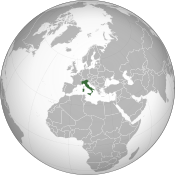Scientist says he predicted Italy earthquake, was ignored
Tuesday, April 7, 2009
Gioacchino Giuliani, a researcher at a Gran Sasso physics institute in Italy, claims that he predicted the powerful earthquake that struck the country on Monday, but was dismissed by the authorities as a scaremonger. According to the United States Geological Survey (USGS) the moment magnitude 6.3 earthquake struck Central Italy at 3:32 a.m. local time on April 6. So far, over 150 people have been killed with over 1,500 injured and tens of thousands of buildings damaged or destroyed. A magnitude 5.1 aftershock struck the same region just under 24 hours later.
Giuliani claims to have predicted the quake by monitoring radon gas emissions. Last month, cars with loudspeakers drove around the area, broadcasting the researcher's warning that a quake would soon strike. He was then reported to the authorities for making false alarms, and was obliged to remove his findings from the Internet.
The researcher demanded that he be given a formal apology. "There are people who must apologize to me, and they must have the weight of what occurred on their conscience," said Giuliani after the earthquake hit.
Giuliani holds a patent on a device measuring atmospheric levels of radon in order to predict earthquakes. In 2005 he gave a seminar at Gran Sasso discussing the device and its use to predict tremors in the area of L'Aquila, but has not published papers on the topic. Giuliani is not a geophysicist or seismologist; rather, he is a technician working on the Large Volume Detector experiment at Gran Sasso, which measures cosmic rays.
The local news agency IlCapoluogo reports that Giuliani gave an interview on March 24, in which he repeated his warning. Authorities, however, say that the earthquake was the result of a series of recent tremors in the area, and it would have been impossible to forecast its magnitude or epicenter.
Giuliani lives in L'Aquila and made his findings while at the National Institute of Nuclear Physics in the nearby Abruzzo region.
The use of radon levels to anticipate seismic events has been under study by the seismological community since the 1970s, but a generally-accepted proven link has not been established.
Related news
- "Major magnitude 6.3 earthquake strikes central Italy" — Wikinews, April 6, 2009
Sources
- "Magnitude 4.9 - CENTRAL ITALY" — USGS, April , 2009
- "Earthquake rocks Italy, killing more than 150" — CTV, April 6, 2009
- "Scientist: My quake prediction was ignored" — CNN, April 6, 2009
- Gavin Jones. "Italy muzzled scientist who predicted quake" — Reuters, April 6, 2009
- "LNGS seminars" — Gran Sasso National Laboratory, April 3, 2009
- Gioacchino Giuliani. "Dal 222Rn un segnale precursore di Eventi Sismici" — Gran Sasso National Laboratory, July 13, 2005 (Italian)
- Gioacchino Giuliani. "(WO/2004/061448) APPARATUS FOR THE DETECTION OF RADON GAS CONCENTRATION VARIATION IN THE ENVIRONMENT, METHOD FOR SUCH DETECTION AND THEIR USE IN FORECASTING OF SEISMIC EVENTS." — WIPO, July 22, 2004
- "Large Volume Detector" — Gran Sasso National Laboratory,
- M. Aglietta et al. "EAS-TOP. Cosmic Ray Experiment" — Gran Sasso National Laboratory, 1997




